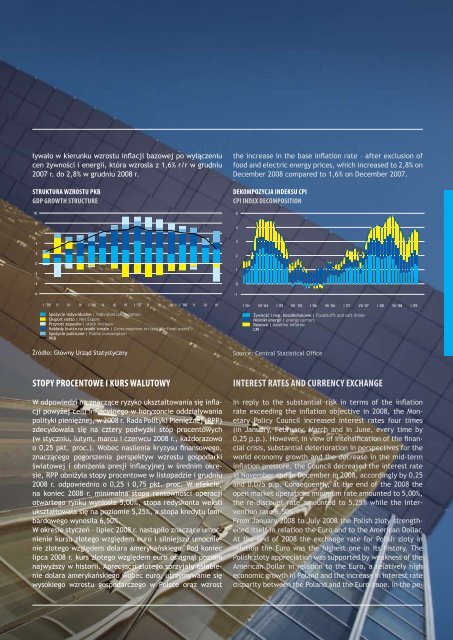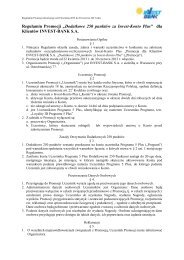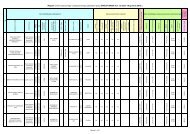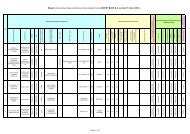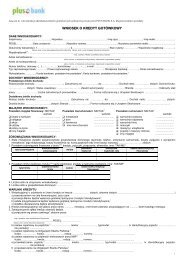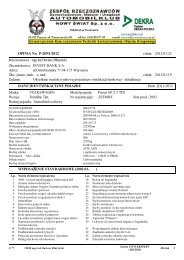Create successful ePaper yourself
Turn your PDF publications into a flip-book with our unique Google optimized e-Paper software.
In reply to the substantial risk in terms of the inflation<br />
rate exceeding the inflation objective in <strong>2008</strong>, the Monetary<br />
Policy Council increased interest rates four times<br />
(in January, February, March and in June, every time by<br />
0,25 p.p.). However, in view of intensification of the financial<br />
crisis, substantial deterioration in perspectives for the<br />
world economy growth and the decrease in the mid-term<br />
inflation pressure, the Council decreased the interest rate<br />
in November and in December in <strong>2008</strong>, accordingly by 0,25<br />
and 0,075 p.p. Consequently, at the end of the <strong>2008</strong> the<br />
open market operations minimum rate amounted to 5,00%,<br />
the re-discount rate amounted to 5,25% while the intervention<br />
rate 6,50%.<br />
From January <strong>2008</strong> to July <strong>2008</strong> the Polish zloty strengthened<br />
itself in relation the Euro and to the American Dollar.<br />
At the end of <strong>2008</strong> the exchange rate for Polish zloty in<br />
relation the Euro was the highest one in its history. The<br />
Polish zloty appreciation was supported by weakness of the<br />
American Dollar in relation to the Euro, a relatively high<br />
economic growth in Poland and the increase in interest rate<br />
disparity between the Poland and the Euro-zone. In the peływało<br />
w kierunku wzrostu inflacji bazowej po wyłączeniu<br />
cen żywności i energii, która wzrosła z 1,6% r/r w grudniu<br />
2007 r. do 2,8% w grudniu <strong>2008</strong> r.<br />
Struktura wzrostu PKB<br />
GDP growth structure<br />
10<br />
8<br />
6<br />
4<br />
2<br />
0<br />
-2<br />
-4<br />
-6<br />
I ‘05 II III IV I ‘06 II III IV I ‘07 II III IV I ‘08 II III IV<br />
Spożycie indywidualne | Individual consumption<br />
Eksport netto | Net Export<br />
Przyrost zapasów | stock increase<br />
Nakłady brutto na środki trwałe | Gross expenses on tangible fixed assets<br />
Spożycie publiczne | Public consumption<br />
PKB<br />
the increase in the base inflation rate – after exclusion of<br />
food and electric energy prices, which increased to 2,8% on<br />
December <strong>2008</strong> compared to 1,6% on December 2007.<br />
Dekompozycja indeksu CPI<br />
CPI index decomposition<br />
5<br />
4<br />
3<br />
2<br />
1<br />
0<br />
-1<br />
I '04 VII '04 I '05 VII '05 I '06 VII '06 I '07 VII '07 I '08 VII '08 I '09<br />
Żywność i nap. bezalkoholowe | Foodstuffs and soft drinks<br />
Nośniki energii | energy carriers<br />
Bazowa | baseline inflation<br />
CPI<br />
Źródło: Główny Urząd Statystyczny<br />
Source: Central Statistical Office<br />
Stopy procentowe i kurs walutowy<br />
W odpowiedzi na znaczące ryzyko ukształtowania się inflacji<br />
powyżej celu inflacyjnego w horyzoncie oddziaływania<br />
polityki pieniężnej, w <strong>2008</strong> r. Rada Polityki Pieniężnej (RPP)<br />
zdecydowała się na cztery podwyżki stóp procentowych<br />
(w styczniu, lutym, marcu i czerwcu <strong>2008</strong> r., każdorazowo<br />
o 0,25 pkt. proc.). Wobec nasilenia kryzysu finansowego,<br />
znaczącego pogorszenia perspektyw wzrostu gospodarki<br />
światowej i obniżenia presji inflacyjnej w średnim okresie,<br />
RPP obniżyła stopy procentowe w listopadzie i grudniu<br />
<strong>2008</strong> r. odpowiednio o 0,25 i 0,75 pkt. proc. W efekcie,<br />
na koniec <strong>2008</strong> r. minimalna stopa rentowności operacji<br />
otwartego rynku wyniosła 5,00%, stopa redyskonta weksli<br />
ukształtowała się na poziomie 5,25%, a stopa kredytu lombardowego<br />
wynosiła 6,50%.<br />
W okresie styczeń – lipiec <strong>2008</strong> r. nastąpiło znaczące umocnienie<br />
kursu złotego względem euro i silniejsze umocnienie<br />
złotego względem dolara amerykańskiego. Pod koniec<br />
lipca <strong>2008</strong> r. kurs złotego względem euro osiągnął poziom<br />
najwyższy w historii. Aprecjacji złotego sprzyjały osłabienie<br />
dolara amerykańskiego wobec euro, utrzymywanie się<br />
wysokiego wzrostu gospodarczego w Polsce oraz wzrost<br />
Interest rates and currency exchange<br />
9


